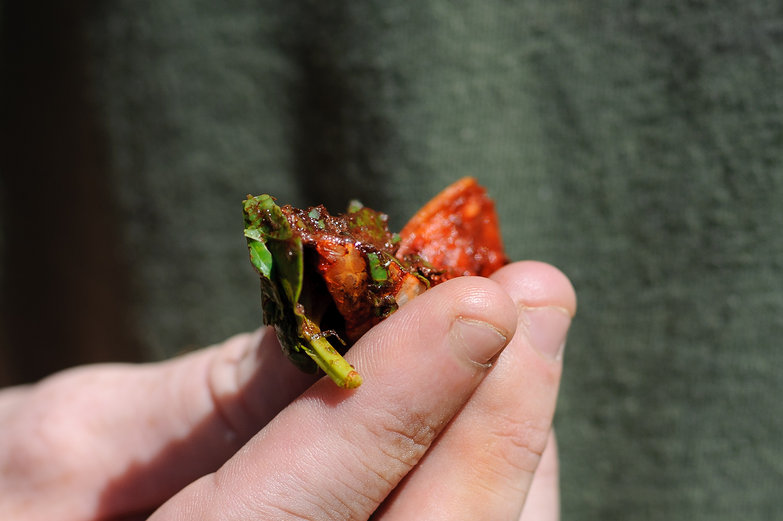In Vietnamese there is a saying that "the betel begins the conversation", referring to the practice of people chewing betel in formal occasions or "to break the ice" in awkward situations.
Wikipedia, Betel
Before we arrived in Bangkok to begin the Thai/Indo-Chinese leg of our journey, we hoped and expected to learn a little bit about the concept of betel chewing, a practice common throughout Southeast Asia in varying forms. Unfortunately, we haven't learned much so far, most of our knowledge coming from the internet instead of actual people.
We do know it's involved in ceremonial rituals and special events such as marriages, but as of yet, we've never seen it used as such. Mostly, we just notice elderly women with strange looks on their faces, seemingly oblivious to the fact that they're drooling red goober from their mouths.
In Thailand, I was happy to meet a woman who was busy using her betel chewing paraphernalia by the side of the road. She happily let me watch and take photos, but unfortunately the language divide was too great for me to ask questions.
The use of betel is so ingrained in Thai culture (for the elderly, anyway), that even when I asked the woman's english-speaking daughter about what her mother was doing and why, she looked a bit confused and answered with with a cursory response that seemed to imply that the act of chewing it was self-explanatory.
She just laughs and shrugs as if the whole process should be obvious, and then answers my question with a simple, unenlightening statement:
"She old. She chew dat."
Into The Jungle: Part One
Though the habit itself has never been appealing to us (longterm affects of usage ranging from gnarly, rotting, toothless mouths to a high rate of mouth cancer) we're curious about what it tastes like, as well as what effect it creates on the body that is so compelling to the legions of old ladies we've see chewing it.
With the thought of trying betel in the back of our minds, we keep our eyes open for it whenever we go to a shop or market. So far we've always returned from our ventures empty handed. The problem really comes down to one thing: we don't even know what we're looking for. Is "betel" a nut? A leaf? What does it look like? Does it come pre-smashed?
On our way out of Da Lat's covered market with Pete and Natasha, I spot a pile of carefully stacked, curved green leaves and a little pot of gritty-looking pink paste. Hmmmm… could this be what we've been searching for?
Sure enough, a round of miming with the woman behind the counter confirms my suspicions. Pete and Natasha are as excited as we are, for they've been wondering the same things. Taking charge of the situation, Natasha sidles up to the counter, points at the leaves, and asks for "one betel please" much the same way she'd order a bowl of soup or an iced coffee. Tactic successful, the remaining three of us go ahead and order them as well.
With what looks like a pallete knife and some thick pink paint, the woman applies a smear of limestone paste to one of the green betel leaves. Then, she places a chunk of areca nut on top, and wraps it up like a bundle.
In Vietnam, the areca nut and the betel leaf are such important symbols of love and marriage that in Vietnamese the phrase "legend of betel and areca" (truyện trầu cau) is synonymous with marriage. The tradition of chewing areca nuts starts the talk between the groom's parents and the bride's parents about the young couple's marriage.
Wikipedia, Areca Nut
We pop the leafy parcels into our cheeks and begin to chew, unsure of what else to do. The flavor is face-puckeringly bitter and cotton-mouth inducing thanks to a wealth of tannins in the areca nut. If I were to try this in the wild, I would probably think "Hey this tastes poisonous…" and then spit it out. But for cultural exploration's sake, we keep chewing, which soon releases a lot of juices that run red in our mouths.

Chewing the wads makes us salivate much more than normal, and we're left with yet another question: are we supposed to swallow the liquid, or spit it out? Or let it dribble down our chins? We're not sure, but keep on chewing the bitter substance. I don't want to swallow, but eventually so much liquid is produced that I do anyway, accidentally lodging a small piece of nut in my throat.
Tyler and Natasha chat blithely as if nothing has changed. Meanwhile, Pete and I begin to feel woozy as if we've somehow boarded a boat that's begun to rock at sea. With the market stalls beginning to sway beneath my feet, and a hunk of bitter, dry areca nut caught in my esophagus, I decide I'm not cut out for betel chewing.
And after a few minutes, we all decide to spit it out. Blech.

It was an interesting experience but I don't think we're going to become regular betel chewers anytime soon, and that's probably a good thing.







